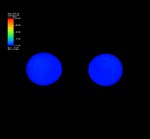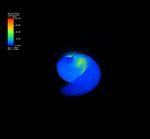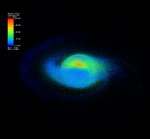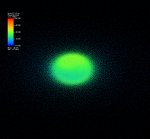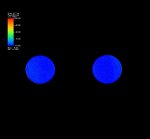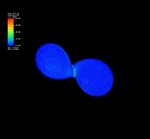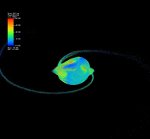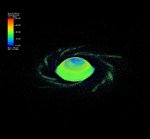|
|  |
The atomic nuclei of all known matter are composed of positively
charged protons and electrically neutral neutrons. Both are built up
by more fundamental constituents, the quarks. In neutrons and protons
only the two lightest of the six identified kinds of quarks are present,
named "up" and "down". In order to produce the other quarks in
terrestrial experiments, physicists use big accelerator machines
like the Large Hadron Collider (LHC) of the European particle physics
laboratory CERN near Geneva, which has become operational only
recently. In the LHC, for example, protons are accelerated to nearly
the speed of light and then brought to collision. For tiny moments
such particle crashes produce conditions as they occurred in the early
universe just fractions of a second after the big bang.
It cannot be excluded that also in the present universe quarks
different from the up and down types exist, in particular the
strange quarks, which are more massive than their
lightest relatives and usually decay quickly
to the energetically preferred nucleonic quarks. However, because
of interactions between the quarks, objects could contain not only
up and down quarks but also strange quarks. A lower energy state
would make such objects more stable than atomic nuclei. They could
exist as tiny clumps of a few hundred nucleons, called
strangelets, and could propagate as cosmic rays through the
interstellar space. Strange quarks could also be present in the
interior of neutron stars, the densest known objects, which are
the extremely compact remnants of the collapse of massive stars.
Such stellar relics would then actually not be neutron stars but
strange stars. These exotic objects would have 1.5 times the solar
mass and a radius of 10 kilometers. With a similar mass as neutron
stars, they would be more compact than the latter, which could be
a characteristic property for their identification. Therefore, in
contrast to neutron stars, their matter would not only be bound by
gravitational forces but by the strong interaction of quarks,
which would also cause their surface to be sharper than that of
neutron stars.
Astronomers conduct intense searches for these strange stars.
Their discovery would be a sensation. It would mean that the
stable, exotic ground state of matter composed of strange quarks
would really exist. Unfortunately, identifying strange stars is
extremely difficult: so far the masses of only a few neutron stars
in binary systems have been measured accurately, but their
radii are either unknown or can be estimated only with large
uncertainties. The known data do not yield a good constraint of
the compactness of the stars.
A team of astrophysicists of the Max Planck Institute for Astrophysics
and the University of Jena together with nuclear physicists of the
Universities of Frankfurt and Heidelberg has now suggested an
alternative way to uncover the existence of strange stars. To this
end the team performed computer simulations to determine the observable
signals that are produced by collisions of two strange matter stars
in a binary system. Binary systems of stars do not exist forever. As
moving masses the system radiates gravitational waves, perturbations
of spacetime, which are predicted by Einstein's theory of General
Relativity and propagate like waves through the fabric of space and
time. Radiating gravitational waves, the circling stars lose energy
and thus gradually approach each other. They orbit around each other
faster and faster, thus radiating more and more gravitational waves,
until they collide in a final catastropy (Figs.1 and 2). When this
happens, a powerful outburst of gravitational waves is produced, which
afterwards subsides when the violent vibrations of the merger
remnant gradually wane and the superheavy compact object eventually
collapses to a black hole. The computer models of the team show that
a variety of properties of the gravitational wave signal of such
a merger event are suitable to discriminate whether the colliding
binaries are neutron stars or strange stars.
Estimates say that these cosmic collisions of two stars composed of
neutron matter or strange matter might happen at most once every
10,000 years in a galaxy like the Milky Way. This is far to rare
to wait for such an event in our cosmic vicinity. However, huge
gravitational-wave antennas like the
 GEO600 instrument
near Hannover, which is operated by the Max Planck Institute for
Gravitational Physics, or the GEO600 instrument
near Hannover, which is operated by the Max Planck Institute for
Gravitational Physics, or the
 LIGO facility
in the USA will be
upgraded in a few years to a sensitivity that will allow them
to capture the weak signals even from the LIGO facility
in the USA will be
upgraded in a few years to a sensitivity that will allow them
to capture the weak signals even from the
 Virgo galaxy cluster,
a concentration of several thousand galaxies at a distance of
65 million light years. Virgo galaxy cluster,
a concentration of several thousand galaxies at a distance of
65 million light years.
Even then the measurement of such gravitational-wave signals
will require quite a bit of luck. It is therefore good that the
team of researchers has pointed out yet another interesting
possibility. The cosmic star crashes also lead to mass ejection
into the stellar environment. If the colliding strange stars are
not too compact, several earth masses can be added as tiny nuggets
of strange matter to the cosmic particle flux pervading the
interstellar space (Fig.2).
With the
 "Alpha Magnetic Spectrometer" (AMS-02)
experiment, which will be installed on the International Space
Station (ISS) next year, strangelets reaching the Earth within
this flow of cosmic rays will be searched for. It would be a real
sensation if AMS-02 could find some hints of their existence.
But even if this does not happen, the models of the astro- and
nuclear physicists will allow them to extract from the measurements
important constraints on the possible properties of strange stars.
In any case, the researchers await with great excitement the moment
when the new experiment is sent on its way to the ISS. "Alpha Magnetic Spectrometer" (AMS-02)
experiment, which will be installed on the International Space
Station (ISS) next year, strangelets reaching the Earth within
this flow of cosmic rays will be searched for. It would be a real
sensation if AMS-02 could find some hints of their existence.
But even if this does not happen, the models of the astro- and
nuclear physicists will allow them to extract from the measurements
important constraints on the possible properties of strange stars.
In any case, the researchers await with great excitement the moment
when the new experiment is sent on its way to the ISS.
A. Bauswein und H.-Thomas Janka
Publications
A. Bauswein, H.-T. Janka, R. Oechslin, G. Pagliara, I. Sagert,
J. Schaffner-Bielich, M.M. Hohle and R Neuhäuser,
Physical Review Letters, 103, 011101 (2009)
A. Bauswein, R. Oechslin and H.-T. Janka, Physical Review D,
2009, submitted
 arXiv:0910.5169 arXiv:0910.5169
Acknowledgement:
The computations were performed at the Rechenzentrum Garching (RZG)
and the Leibniz-Rechenzentrum Garching (LRZ). We thank Markus Rampp
(RZG) for visualization of our simulation results. The use of the
Splotch visualization package by K. Dolag, M. Reinecke, C. Gheller
and S. Imboden is acknowledged.
|
